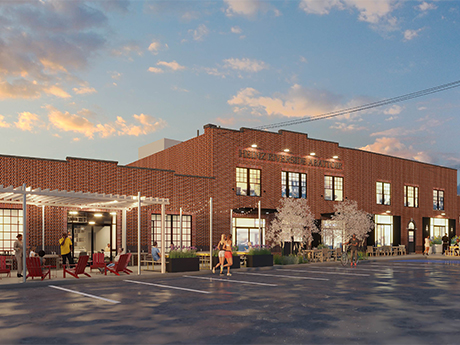Mirroring sentiments expressed at the year-end ICSC conference in New York City, with the national vacancy rate hovering around 5 percent and new concepts anxious to take a foothold in the area, there continues to be tremendous optimism for the retail sector in the greater Baltimore metropolitan region.

Although ground-up development projects remain rare locally, several high-profile adaptive projects are in the works that are placing smiles on brokers’ faces because they have something to lease. Value-oriented retailers, together with quick-service restaurant (QSR) concepts, are showing the most activity.
Adaptive reuse
The redevelopment of the iconic Harborplace festival marketplace (more on that later) is grabbing all the headlines in Charm City, but the adaptive reuse of Baltimore’s Penn Station — the epitome of a transit-oriented development and the renovation of a historic industrial building at Riverside in South Baltimore — are happening now.
Beatty Development Group and Cross Street Partners are partnering with Amtrak to transform the train station originally developed in 1911 into a mixed-use project combining 1 million square feet of commercial office, retail and residential space. Destination retail and restaurants are a central core of the program.

Urban Pastoral and The Wilhide Family are transforming the 135-year-old former Heinze Abbatoir, which is a historic slaughterhouse located at 1900 Light St. Riverside is being transformed into a 35,000-square-foot retail and restaurant project with the goal of attracting locally owned cafés, bakeries, coffee roasters, maker spaces and gyms. The local owner-development team aims to create a venue featuring area talent and creating a place for residents of the more than 1,500 new apartments within a quarter-mile from the project.
Ambitious work is also being completed at Baltimore Peninsula, formerly known as Port Covington, with retail opportunities currently available on the ground floor of several office and multifamily buildings. Rye Street Tavern, operated by Clyde’s Restaurant Group, Slutty Vegan and Bar Vegan, BK Lobster and Jersey Mike’s Subs represent the first wave of restaurants to commit to the development, joining Roost coffee shop and Ben & Jerry’s.
Further up Light Street, MCB Real Estate unveiled preliminary plans to “reestablish the front lawn of Baltimore City” with a new vision featuring a 200,000-square-foot commercial building; 200,000-square-foot retail and commercial building housing food-and-beverage options; a 2,000-seat amphitheater; and two high-rise residential towers. While the plan is generating heated discussion, many agree that having a visionary and local team in charge will be a vast improvement for the city.
Just down the road, all eyes are on new Baltimore Orioles owner David Rubenstein and the Baltimore Ravens as the groups decide on the proper strategy to redevelop the entire stadium district with a goal of generating heightened engagement. Retail and restaurants — destinations that draw local consumers and visitors — will be central to that strategy. Under the prior team ownership, there were thoughts of creating an entertainment district surrounding these venues similar to The Battery in Atlanta, which surrounds the Atlanta Braves’ home ballpark Truist Park.
Food, value-oriented retailers
QSRs and fast-casual restaurants remain in high demand. Making moves in the greater Baltimore market are Raising Cane’s, Chipotle Mexican Grill — including several locations featuring its new “Chipotlane” drive-thru concept — as well as Hangry Joe’s and Buffalo Wild Wings GO.
Some interesting small pad users are taking advantage of excess land that is generally too small for anyone else to use. Brands such as Seven Brew Coffee, a drive-thru-only coffee and beverage concept with a small, 550-square-foot footprint, and Take 5 Oil Change, a concept in which consumers remain in their cars during the 10-minute service routine, are inking their first sites in the market. And it seems as if every other new lease signed in the area is for a new pickleball venue.
Consumers are generally still feeling the economic pinch caused by rising prices and, when that happens, lower-priced restaurants and retailers are the beneficiary. Dollar General plans to add more than 800 stores this year, including many in the greater Baltimore area. Grocery Outlet, a value retailer of name-brand consumables and fresh products with more than 450 stores in eight states, opened its first store in Carroll County. Other brands on the move locally are Aldi, HomeGoods, Harbor Freight Tools, Lidl and Ollie’s Bargain Outlet.
The retail landscape has already begun adapting to a future involving electric vehicles (EV) and, critical to their proliferation, the infrastructure to support them. A handful of EV chargers have been popping up in shopping center parking lots. But to achieve scale, the industry needs to create charging plazas that can accommodate many vehicles at once and offer the fastest available charging systems. Today, a full charge at top current speed can still take 30 minutes.
So, be on the lookout for the arrival of Applegreen. The combination convenience store/EV charging station with 80 locations in the United States is aggressively scouting locations throughout Maryland.
— By Mark Mueller and Glenn Ulick, Senior Vice Presidents of Retail Brokerage at Lee & Associates | Maryland. This article was originally published in the April 2024 issue of Southeast Real Estate Business.


